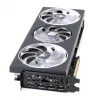Final words and conclusion
The HellHound edition is designed with a higher power budget and increased clock speeds, leading to slightly better performance—about 2-3% on average—when compared to similar products from other manufacturers. The Hellhound graphics card features a 14-layer PCB and utilizes a 9+2+1 phase VRM design with DrMOS to supply power to the GPU. Additionally, it includes a separate 2+1 phase VRM specifically for powering the VRAM. The card has a Total Graphics Power (TGP) of 228W in overclocking mode and 212W in silent mode. The 7900 GRE model presents a unique position within the 7900 series, as it offers 10-15% lower performance than the 7900 XT and has 20% less memory compared to the XT version. This model appears to target competition with NVIDIA's 4070 Ti and 4070 SUPER in the Western markets, particularly in rasterization performance, where it holds its ground. Currently, the 4070 SUPER is priced at around $649. The 7900 GRE's performance aligns closely with that of AMD's previous 6950XT and 6900XT models. While AMD's graphics cards offer strong overall performance, they tend to underperform in Ultra HD settings, especially with ray tracing, where they still fall behind NVIDIA's more rapid advancements in this technology. The introduction of features like FSR aims to improve AMD's ray tracing capabilities in higher resolutions, though it may slightly compromise image quality.
Cooling & noise levels
Our test shows that gaming will get you an approximate volume level of 38 decibels (perf bios), rendering it relatively muffled. Moreover, the graphics card temperature is 55~60 degrees Celsius depending on BIOS mode. The maximum hotspot temp sits close to 75-80 Degrees C. Our utilization of FLIR imaging did not unveil any worrisome observations in the thermal image.
Energy
Remember that the Radeon RX 7900 GRE is a high-end gaming product that still uses much power. Under full load, the baseline editions uses about 260 Watts (average TBP), and the tested card is closer to 300W. This Wattage is directly related to how much heat the GPU, which sits inside a closed case, gives off. Overall, FPS versus Wattage, this card does well.
Coil whine
Every graphics card will inevitably produce a discernible buzzing sound known as coil whine when operating at high FPS. Is it bothersome? It becomes noticeable once you push the frame rates to extremely high levels. In a closed computer case, this noise tends to recede into the background. However, when the chassis is open, the coil whine or squeal becomes audible. Almost all graphics cards exhibit this phenomenon to some extent, particularly when operating at higher frame rates. Despite its presence, we have not noticed it enough to be a noteworthy inconvenience.
Pricing
Admittedly I did not expect to really like something call 'Golden Rabbit Edition' as it's a reshuffled SKU based on the 7900XT. However once I started testing this product I swayed around quite a bit, as at a projected $549 the GRE does offer quite a bit of value for money. I mean the XT model is hovering at $779 and the 16GB memory certainly is plentiful also. That said, it'll remain to be a hard sell with fierce competition from NVIDIA. But the WQHD and Ultra HD domains are perfectly playable with this card. We expect the HellHound to sell at roughly $579 , for that money you do get a lot of card.
Tweaking
The card can be effectively tweaked with ease; however, AMD applied maximum values. One beneficial feature is the power limiter, allowing for a wattage increase of up to +15%. This serves as the initial and fastest option for tweaking. By utilizing this option, you can achieve enhanced performance while staying within the card's default power allocation. Additionally, the boost clock frequency can be set at a suitable 2800MHz. Furthermore, the memory can be optimized to operate at around 18.5 Gbps as it is limited. When all these adjustments are combined, they result in approximately 4% additional performance gains in demanding GPU scenarios, measured relative to the baseline performance. Once you apply a bit of undervolting you can stretch the values a bit more and gain an 8-(% performance increase coming from reference, not bad.
Conclusion
The HellHound edition graphics card offers enhanced power allocation and increased clock speeds, leading to slightly faster performance than its counterparts from other board partners, with a performance edge of approximately 2-3%. The card impresses with its quiet operation, even when set to performance BIOS mode. Under intense gaming conditions, it maintains a temperature around 55-60 degrees Celsius, which is excellent. Users have the option to further improve performance through regular overclocking and potentially reach a 10% increase with thorough undervolting. Priced at $599, the card offers performance comparable to the 6900 Series, featuring a clock speed range of 2300 MHz and efficient power consumption. Despite a reduction to a 16GB / 256-bit bus, the 16GB memory is currently sufficient for most uses. When comparing with competitors, particularly NVIDIA's 4070 SUPER, the card holds its own with advantages in rasterization, though it falls short in ray tracing and DLSS 3.5 capabilities. The 7900 GRE HellHound stands out for its quiet operation, design, and performance within AMD's lineup of high-end cards. While it slightly underperforms compared to the 7900 XT, it compensates with better energy efficiency. The market for high-end graphics cards is highly competitive. PowerColor's pricing strategy for the HellHound Spectra White edition, at $30 above MSRP ($579), might appeal to those valuing silent operation and design. Despite the higher price, the card's performance and aesthetics make it a strong contender among RX 7800 GRE models.
- Download AMD Radeon drivers
- Sign up to receive a notification when we publish a new article.
- Or go back to Guru3D's front page
- Hilbert, LOAD"*",8,1.




